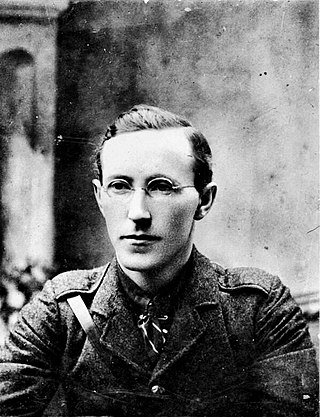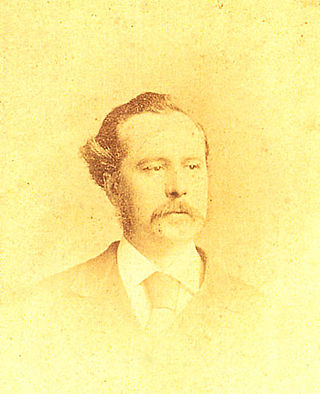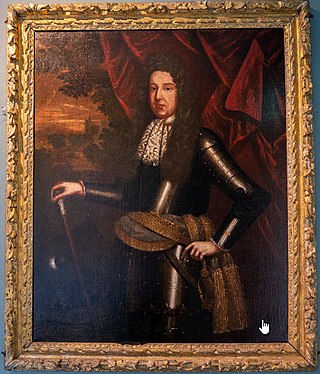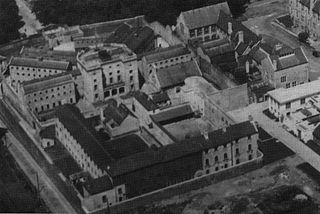The Kents were a family of prominent Irish nationalists and republicans from Castlelyons, County Cork active from the 1870s until the 1930s.
The Kents were a family of prominent Irish nationalists and republicans from Castlelyons, County Cork active from the 1870s until the 1930s.
At the time of the Land War the Kent family, comprising David Kent, his wife Mary (née Rice), and their nine children (seven sons & two daughters), lived in an Irish-speaking household at Bawnard House, Coole, Castlelyons, County Cork (William Kent, "For generations our family had farmed 200 acres at Bawnard"). [1] [2]
David Kent died in 1876 (the year after his youngest child Richard was born); he was 44 years old. [3] Mary Kent (née Rice) had grown up in nearby Towermore and had family living in the locality. In 1887 her nephews Austin and Richard Rice were evicted from their farm for non-payment of rent and this began a series of events which would bring the Kents to national prominence.[ citation needed ]
The Rices had initially leased the farm from the Peard family but in July 1888, it was sold to Orr McCausland, a Belfast-based landowner and their homestead was occupied by a steward and a general manager (Robert Browne, reportedly a native of Scotland). The Kents and their cousins, the Rices, teamed up with Father Jeremiah O’Dwyer, the parish curate, to launch a boycott against Browne. As leading players of the Castlelyons and Coolagown branch of the Irish National League, they organised a meeting at Coolagown. Addressing a crowd of nearly 300 people, Fr. O’Dwyer asked them to ensure that Browne did not lose his life in case things became ‘too hot’ to handle. [1] [2]
In the autumn of 1889, four Kent brothers - David, Edmond, Richard, and William – were among ten men hauled into a crowded Fermoy Courthouse, charged with orchestrating a boycott campaign. In court, Browne also told how Edmond Kent, the eldest brother, threatened him on Fermoy bridge, while David Kent had blown horns at him and called him a ‘land-grabber’ outside Coolagown Church. The second oldest Kent brother, Thomas, did not appear in the dock because he was in the USA (he had emigrated to Boston in 1884 and had spent the intervening years working as a church furniture maker and dabbling publishing; had he been present he could have been tried after being accused of throwing eggs at Browne's car). [1] [2] The court took a dim view on the defendants and imposed some harsh sentences; Fr. O’Dwyer was sentenced to six months in prison, Edmond and William were given four months with hard labour and David was given two months with hard labour (Richard was not given a prison sentence).[ citation needed ]
From the dock, Edmond shouted, ‘Death or victory is our war-cry, and then the Saxon chains will break’, while another prisoner called Callaghan McCarthy managed to loose off a few bars of ‘God Save Ireland’ on a flute. The prisoners were handcuffed, taken out to a wagonette and driven to the railway station from where a special carriage transported them to Cork Gaol. Anticipating the crowd of several thousand who gathered to cheer the prisoners, the authorities provided the prisoners with an escort of 200 soldiers of the Royal Warwickshire and West Cork Regiments, with bayonets fixed. [2]
The boycott on Browne resumed when the Kents had served their time. At the close of May 1890, Tom (who had returned from Boston) and his brother William were charged, alongside Austin Rice, with intimidating Mary Murphy, an elderly woman who worked for Browne, by making sure she was unable to purchase a pig at the fair. During their trial, Browne, now under police protection, told how horns were continually blown towards his house from the Kent residence. When the magistrate sentenced the brothers to one month's imprisonment, with hard labour, William roared ‘Victory is our cry and our motto no surrender’ while Thomas slammed his fist upon the desk and shouted "God save Ireland". Uproar followed and the police were ordered to clear the court. As the prisoners were escorted to the railway station, District Inspector Ball became so unnerved by the cheering crowd that he ordered his men to charge with their batons and several people were injured. The army then blocked Fermoy Bridge and cleared the streets. [2]
Thomas and William Kent were still in prison when a fresh case came before Fermoy Court in June 1890. They were amongst seven men accused of attempting to ‘compel and induce’ fourteen members of McCausland's workforce to leave his employment. William was described as the ringleader of a campaign to intimidate McCausland's staff when they attempted to attend Mass at Coolagown Chapel. The case was raised at the House of Commons in London where both Kent brothers were named. Arthur Balfour, the Chief Secretary, described "the most disgraceful scenes … enacted Sunday after Sunday". William Kent was accused of spitting upon the workers and their families, having ‘performed the acrobatic feat of entering the chapel by the window and assisted others to enter the same way.’ There was also much ‘jeering and jibing the police’. Thomas Kent took ‘an active part in the disgraceful proceedings, but was not at all so bad as his brother William.’ Heavy sentences followed - six months hard labour for William, two for Thomas – and once again a cheering crowd followed them to the train station in Fermoy. [2]
William Kent later left an account of the whole boycott episode, "In 1889 my brothers, Edmond, Richard and David, the local curate, Rev. Father O'Dwyer, and myself were arrested. Owing to his youth, the younger brother, Richard, was acquitted by the resident magistrates, Colonels Gardiner and Caddell. David received six months' hard labour; Edmond and I were each sentenced to four months' hard labour. The charge was conspiracy with others to evade payment of rents. The sentences were served in Cork County Jail. For refusing to enter into bail for our future good behaviour we served an additional three months' imprisonment. A short time after our release, my other brother, Thomas, who had been in America, returned and threw his lot into the fight. Both he and I were arrested under the Balfour Coercion Acts. Another trumped-up charge of conspiracy was brought against us. I was sentenced to six months' hard labour and Thomas was sentenced to two months. These sentences were served in Cork Jail. On our release we were met by thousands of people in Fermoy who escorted us all the way home to Bawnard." [1]
In January 1899, Tom attended a meeting in Castlelyons to select a candidate to represent the Fermoy and Castlelyons district on Cork County Council. To loud applause, he told the crowd of the six policies he believed the candidate must be pledged to, namely Home Rule, the establishment of a Catholic University, the release of political prisoners, the reinstatement of evicted tenants and the compulsory sale of land to tenant farmers. When Michael Mackay of Ballyroberts was proposed as the Nationalist candidate, the motion was seconded by David Kent who seized the opportunity to point out to the gathering that the Unionist candidate, Colonel Johnson, had been Hon. Secretary to the Landlord's Association. A show of hands was called for at the end of the evening. Mackay won by a huge majority. [2] Tom became an avid supporter of the Gaelic League and later of Arthur Griffith's Sinn Féin [2]
By 1901, Mary Kent (age 60) was living at Bawnard House with five of her bachelor sons and one of her daughters. The Kent home was under constant surveillance by the RIC. [2] In 1913 two of the four Kent brothers, Thomas and David, became active in the Irish Volunteer and they started a Castlelyons Branch of the organisation; William Kent, "In 1914 and 1915 Thomas and David took an active part with Terence MacSwiney in the enrolment of the Irish Volunteers. They called a meeting at Clonmult and got the famous Clonmult hurlers to march to the village of Dungourney where a British recruiting meeting was being held. Thomas and David led the men through this meeting, and, halting a short distance away from it, addressed the crowd, advising them to join the Volunteers and have nothing whatever to do with the British Army." [1]
The Castleyons branch of the Irish Volunteers was said to be the first teetotal branch of the organization in Ireland and many of their training maneuvers took place in the woods around the Kents home at Bawnard. In August 1915, Thomas Kent attended the funeral of the Fenian leader Jeremiah O'Donovan Rossa in Glasnevin, Dublin, at which Patrick Pearse delivered his celebrated oration. [2]
William Kent stated, "Early in January, 1916, Thomas and Terence MacSwiney were arrested and charged before a bench of magistrates in Cork with making seditious speeches at Ballynoe. They were acquitted. Within a week or two Thomas was again arrested and sentenced to two months imprisonment because arms and ammunition were found in the house." [1]
In 1916, during the round-up in the aftermath of the Easter Rising the RIC raided Bawnard House, and Mary Kent and her four sons Thomas, David, William, and Richard resisted arrest. William Kent recounted, [1]
"Early on the following morning [2 May 1916] we were awakened by loud knocking on the hall door. The house was surrounded by British Crown Forces. I was sleeping in the Eastern side of the house. I jumped out of bed, put my head out of the window and asked "Who's there?". The answer was "Police; come down". I immediately awakened Tom, who was sleeping in the Western side of the house, and said, "The whole place is surrounded. We are caught like rats in a trap." Tom put some clothes on, armed himself with a rifle, and, without showing himself, called to those below, "What do you want?". As expected, the answer came, "We are police and have orders to arrest the whole family." The reply was given definitely by the whole family, "We are soldiers of the Irish Republic, and there is no surrender". Our mother, then over eighty years of age, dressed herself, and all during the ensuing fight assisted by loading weapons and with words of encouragement. The police fired a volley to which we replied and a fierce conflict began. We were armed with three shot guns and a rifle. The fight lasted about three hours. Head Constable Rowe was shot dead, while other members of the R.I.C. were wounded. David was also badly wounded, having lost two fingers and received a gaping wound in his side. Military reinforcements arrived and when the last shot was fired from the house we had no alternative but to surrender, Our ammunition was exhausted. The house was wrecked. Not a pane of glass was left unbroken. The interior was tattooed with marks of rifle bullets. The altar and statues in the Oratory alone escaped destruction. All around the altar plaster was knocked off the walls but not one of the statues was struck. At one time the fire of the attackers was attracted to the window of the Oratory where they thought a girl was firing at them. Strange to say, it was the statue of our Lady of Lourdes they saw from outside. The same statue was bought by my brother Tom at the sake of Father Ferris's household effects. Father Ferris had brought it from Lourdes and I attribute to it the fact that our lives and home were saved from complete destruction. The greatest safeguard of all is to have a statue in the house. Following the surrender we were taken out through a window assisted by the military. Thomas was not permitted time to put on his boots. Thomas and I were immediately handcuffed. Richard, a famous athlete, was not immediately handcuffed and in the confusion he attempted to escape by bounding over a hedge nearby. He was fired on and fell, mortally wounded. We were then lined up against a wall of the house by the R.I.C. who prepared to shoot us, when a military officer interposed himself between us and the firing party. Ordering the police to desist, he said, "I am in command here. Enough lives have been lost, and I take these men prisoners of war."
The following week, Thomas Kent (aged 51) was convicted of the murder of Constable Rowe at court-martial in Victoria Barracks, Cork. On 9 May, he was executed by firing squad at the Barrack's Prison. His nerves were so bad on the morning of his execution that the guards had to bring a chair for him to sit upon. [2] His body was then buried in qucklime in an unmarked plot in the prison yard. [4]
Richard Rice Kent died of his injuries on 4 May 1916. [5] David Kent was transferred to Richmond Barracks in Dublin, where he was sentenced to death but this sentence was later commuted to penal servitude for life. Subsequently, he was moved to HM Prison Pentonville in England.[ citation needed ] While their his mother, Mary Rice Kent, died. He was released from prison by amnesty in 1917. [1] [6] [7]
At the 1918 general election, David Kent was elected unopposed as a Sinn Féin MP for the Cork East constituency. [8] After the Irish War of Independence he opposed the Anglo-Irish Treaty and voted against it. He was re-elected in Cork East at the 1922 general election and remained a TD until the 1927 general election when his brother William ran in his place. [9]
William was elected as a Fianna Fáil Teachta Dála (TD) for the Cork East constituency at the September 1927 general election but was not reelected in 1932. [8]
In the late 1920s, David Kent was sent to the United States to raise money for the Republican cause and he died shortly after his return: William Kent, "He was sent to America on a mission of propaganda on behalf of the I.R.A. He returned home after some months far poorer in health, and, after a life of struggle for the freedom of his country, this brave soldier and patriot died at his home at Bawnard on the 16th November, 1930." [1]
At the 1933 general election William was elected as a National Centre Party TD and did not run for re-election in 1937. [9] William Kent died in 1957, he was 84 years old and was the "last survivor of the band of local Land League fighters". [1]

Thomas Kent was an Irish nationalist who was court-martialled and executed following a gunfight with the Royal Irish Constabulary (RIC) on 9 May 1916, in the immediate aftermath of the Easter Rising.

William Fanaghan Lynch was an Irish Republican Army officer during the Irish War of Independence of 1919–1921. During much of the Irish Civil War, he was chief of staff of the Irish Republican Army. On 10 April 1923, Lynch was killed whilst trying to escape an encirclement by Free State troops in south Tipperary.

Gerald FitzGerald, 14th Earl of Desmond, also counted as 15th or 16th, owned large part of the Irish province of Munster. In 1565 he fought the private Battle of Affane against his neighbours, the Butlers. After this, he was for some time detained in the Tower of London. Though the First Desmond Rebellion took place in his absence, he led the Second Desmond Rebellion from 1579 to his death and was therefore called the Rebel Earl. He was attainted in 1582 and went into hiding but was hunted down and killed.

Edward Welby Pugin was an English architect, the eldest son of architect Augustus Welby Northmore Pugin and Louisa Barton and part of the Pugin & Pugin family of church architects. His father was an architect and designer of Neo-Gothic architecture, and after his death in 1852 Edward took up his successful practice. At the time of his own early death in 1875, Pugin had designed and completed more than one hundred Catholic churches.

Sir Donough MacCarty, 1st Earl of Clancarty (1594–1665), was an Irish soldier and politician. He succeeded his father as 2nd Viscount Muskerry in 1641. He rebelled against the government and joined the Irish Catholic Confederation, demanding religious freedom as a Catholic and defending the rights of the Gaelic nobility. Later, he supported the King against his Parliamentarian enemies during the Cromwellian conquest of Ireland.

Thomas Hales was an Irish Republican Army (IRA) volunteer and politician from West Cork.
David Barry, 1st Earl of Barrymore (1605–1642), 6th Viscount Buttevant from 1617 to 1628, was a Protestant native Irish peer. He died of wounds received at the battle of Battle of Liscarroll in September 1642.
Edmond Burke Roche, 1st Baron Fermoy, was an Irish politician in the Parliament of the United Kingdom who was granted a title in the Peerage of Ireland. His direct ancestor was Maurice FitzEdmund Roche, Mayor of Cork, who died in 1593.

Castlelyons is a small village in the east of County Cork, Ireland. It is also a civil parish in the barony of Barrymore. The name is derived from a stronghold of the Uí Liatháin - an early medieval kingdom. It is situated 6 km (3.7 mi) south of Fermoy. In the 2016 census it recorded a population of 374. Castlelyons is part of the Dáil constituency of Cork East.

Michael Fitzgerald also known as Mick Fitzgerald, was among the first members of the Irish Republican Army and played a significant role in organising it. He rose to the rank of Commandant, Officer Commanding (OC) in the First Battalion, Cork Number 2 Brigade. He died during the 1920 Cork hunger strike at Cork Gaol. Fitzgerald led 65 men in the hunger strike which was in protest at their detention without being either charged or convicted of any crime. The hunger strike is credited with bringing additional world-wide attention to the Irish cause for independence.
David Rice Kent was an Irish Sinn Féin politician.
William Rice Kent was an Irish politician from County Cork.

St Colman's College is an all-boys voluntary secondary school, and former boarding school, in Fermoy, County Cork. The College was founded in 1856 and opened in 1858 as the diocesan college of the Roman Catholic Diocese of Cloyne. Archbishop Thomas Croke, after whom Croke Park is named, became the school's first President in this year. The College is renowned for its sporting history.

William Neil Rowe was a member of the Royal Irish Constabulary (RIC), fatally shot during a police raid on the home of the Kent family at Castlelyons, County Cork.

James fitz John FitzGerald, 13th Earl of Desmond, also counted as the 14th, ruled 22 years, the first 4 years as de facto earl until the death of James FitzGerald, de jure 12th Earl of Desmond, called Court Page, who was murdered by James fitz John's brother Maurice fitz John FitzGerald, called Totane. James fitz John FitzGerald maintained himself in power by skilful diplomacy, avoiding armed conflict and destruction. He was appointed Lord Treasurer of Ireland in 1547.

The Fenian Rising of 1867 was a rebellion against British rule in Ireland, organised by the Irish Republican Brotherhood (IRB).

The Battle of Cloghleagh, also known as the Battle of Funcheon Ford or the Battle of Manning Water, was fought between a Royalist force and an Irish Confederate force during the Irish Confederate Wars. It took place south of Kilworth and north of Fermoy between the River Funshion and the River Blackwater in County Cork on 4 June 1643. The result was an Irish Confederate victory.
Patrick Joseph O'Keeffe was an Irish soldier and long-time administrator of the Gaelic Athletic Association (GAA). Páirc Uí Chaoimh, the home of the Cork GAA, is named after him.

Cork County Gaol was a former prison located in Cork, Ireland. The main walls and gate entrance of the prison are today incorporated in the perimeter of University College Cork.
The 1920 Cork hunger strike occurred in late 1920, during the Irish War of Independence, when 65 men interned without trial in Cork County Gaol went on hunger strike, demanding release from prison, and reinstatement of their status as political prisoners. Beginning on 11 August 1920, they were joined the following day by the Lord Mayor of Cork, Terence MacSwiney. A week into the hunger strike, all but 11 of the hunger strikers were released or deported to prison in England, with MacSwiney being among the latter.